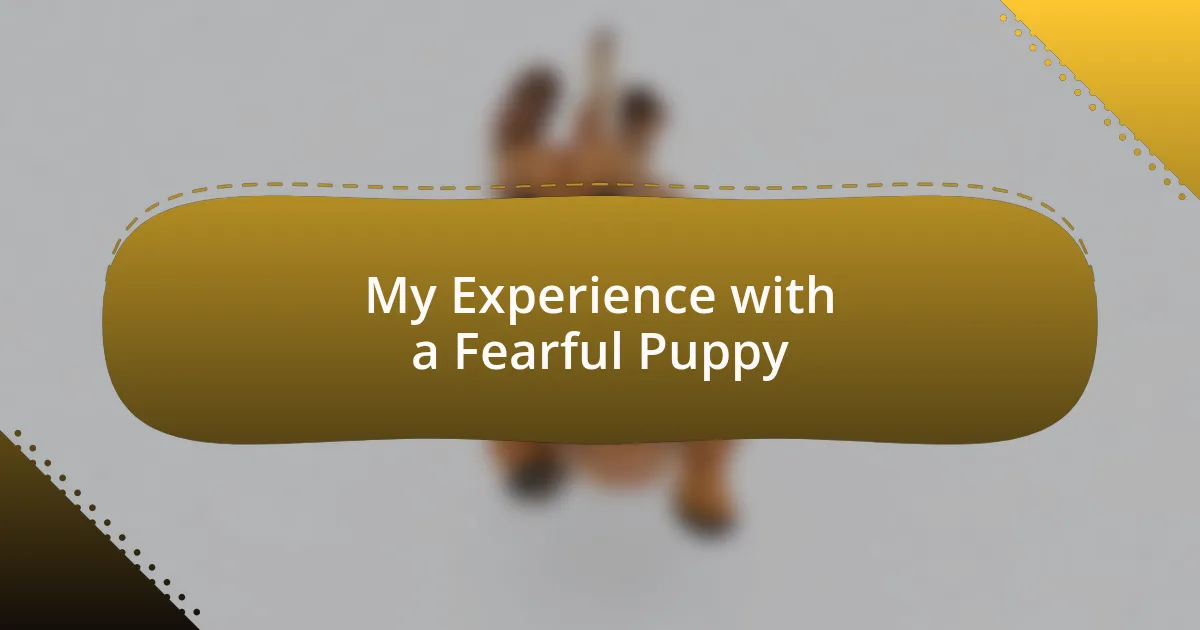Key takeaways:
- Understanding dog behavior through literature can help decode a puppy’s emotions and actions, leading to better training and building trust.
- Techniques like positive reinforcement and desensitization are effective for managing fearful puppies, helping them associate new experiences with positive outcomes.
- Creating a safe space for a puppy can significantly reduce anxiety and empower them to heal.
- Patience, consistency, and celebrating small victories are crucial in fostering a trusting bond with a fearful puppy.
Author: Clara Ashford
Bio: Clara Ashford is an acclaimed author known for her evocative storytelling and richly drawn characters. With a background in psychology and literature, she weaves complex narratives that explore the human experience and emotional depth. Her debut novel, Whispers in the Wind, captivated readers and critics alike, earning her a place among contemporary voices in fiction. Clara resides in the Pacific Northwest, where the lush landscapes inspire her writing. When she’s not crafting her next tale, she enjoys hiking, painting, and engaging with her vibrant community of fellow writers.
Understanding dog behavior books
Dog behavior books serve as essential resources for anyone looking to understand the complex emotions and actions of their canine companions. I vividly recall the first time I picked up a book on dog behavior when I welcomed my fearful puppy home. The way the author described the roots of anxiety and fear in dogs struck a chord with me; it made me realize that my puppy’s quivering wasn’t just typical shyness but a sign of deeper issues.
As I turned the pages, I found myself nodding along, connecting the dots between behavior and emotional state. For instance, reading about how socialization can alleviate fear helped me craft a plan to introduce my pup to new environments gradually. Have you ever wondered how those seemingly small changes can lead to better behavior? It’s phenomenal to see a terrified puppy begin to transform through patient training and knowledge.
Engaging with these books has taught me that every dog is an individual, often shaped by their unique experiences. One particular chapter I remember spoke about different temperament types, which helped me reflect on my own puppy’s reactions. It’s like having a personalized guidebook for addressing their needs—what if you could decode your dog’s quirks with just a bit of study? The insights gained from understanding dog behavior can make a world of difference in building a trusting relationship with our furry friends.
Key techniques for fearful puppies
One of the most effective techniques for managing a fearful puppy is positive reinforcement. Whenever my puppy displayed even a hint of courage—like taking a step toward a new noise—I made sure to reward him immediately with treats or praise. This approach reinforced the behavior I wanted to see while helping him associate new experiences with something positive. Have you noticed how quickly a puppy can adapt when they realize that facing their fears can bring them rewards?
Desensitization is another crucial technique, which involves gradually exposing your puppy to the things that scare them in a controlled and safe manner. I remember introducing my pup to a busy street by first sitting nearby at a distance where he felt safe, slowly getting closer over time. I was amazed at how, with each exposure, his trembling lessened, and his confidence began to build. If we can take it slow, why should we rush our puppies through their learning process?
Creating a safe space is vital for any fearful puppy. I found that designating a quiet corner in my home, complete with cozy bedding and toys, allowed my puppy to retreat when he felt overwhelmed. This space reassured him that he could escape when things felt too much. Have you ever thought about how a little haven can dramatically reduce anxiety for a puppy? It’s remarkable to see how a simple, nurturing environment can empower them to heal.
Lessons learned from my experience
Throughout my journey with my fearful puppy, I learned the importance of patience. There were days when I felt frustrated, watching him flinch at the slightest noise. But it was during those moments that I realized rushing him only increased his anxiety. Instead, I took a step back and allowed him to dictate the pace, which ultimately fostered a bond built on trust. Have you ever found that slowing down can lead to deeper connections?
One key lesson was that consistency in my approach made a world of difference. I remember a time when I varied my training methods, and my puppy seemed confused. He thrived on routine, which made me reflect on how even small changes can disrupt their sense of security. Establishing a familiar pattern in our interactions created a sense of safety for him. Isn’t it fascinating how predictable environments can provide comfort?
Finally, I discovered the power of celebrating small victories. Each time my puppy showed even a hint of bravery, whether it was greeting a new person or exploring a new sound, I made it a point to celebrate those moments. I felt a rush of joy witnessing his growth, which made every bit of effort worthwhile. Have you ever realized how acknowledging little achievements can fuel further progress? It’s those tiny steps that accumulate into real transformation.

Leave a Reply